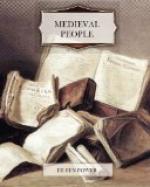Here is something very different from the modest Thomas Betson’s injunction: ’The costes of my burying to be don not outrageously, but sobrely and discretly and in a meane maner, that it may be unto the worship and laude of Almyghty God.’ The worthy old clothier was not unmindful of the worship and laud of Thomas Paycocke also, and over L500 in modern money was expended upon his burial ceremonies, over and above the cost of founding his new chantry. Well indeed it was that his eyes were closed in death, ere the coming of the Reformation abolished all the chantries of England, and with them the Paycocke chantry in St Katherine’s aisle, which had provided alms for six poor men weekly. Thomas Paycocke belonged to the good old days; in a quarter of a century after his death Essex was already changing. The monks were scattered from the abbey, which stood roofless; the sonorous Latin tongue no longer echoed in the church, nor priests prayed there for the souls of Thomas and his wife and his parents and his father-in-law. Even the cloth industry was changing, and the county was growing more prosperous still with the advent of finer kinds of cloth, brought over there by feat-fingered aliens, the ‘new drapery’, known as ‘Bays and Says’. For as the adage says:
Hops, reformation, bays
and beer
Came into England all
in a year,
and Coggeshall was destined to become more famous still for a new sort of cloth called ‘Coxall’s Whites’, which Thomas Paycocke’s nephews made when he was in his grave.[16] One thing, however, did not change; for his beautiful house still stood in West Street, opposite the vicarage, and was the delight of all who saw it. It stands there still, and looking upon it today, and thinking of Thomas Paycocke who once dwelt in it, do there not come to mind the famous words of Ecclesiasticus?




